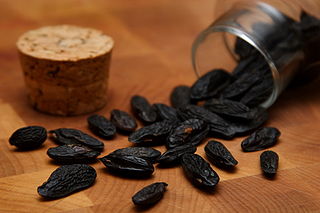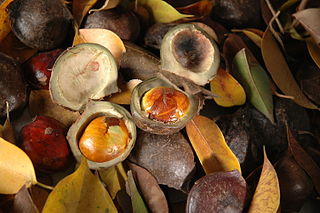
In botany, a fruit is the seed-bearing structure in flowering plants that is formed from the ovary after flowering.

Rambutan is a medium-sized tropical tree in the family Sapindaceae. The name also refers to the edible fruit produced by this tree. The rambutan is native to Southeast Asia. It is closely related to several other edible tropical fruits, including the lychee, longan, pulasan, and quenepa.

The papaya, papaw, or pawpaw is the plant species Carica papaya, one of the 21 accepted species in the genus Carica of the family Caricaceae. It was first domesticated in Mesoamerica, within modern-day southern Mexico and Central America. It is grown in several countries in regions with a tropical climate. In 2020, India produced 42% of the world's supply of papayas.

Catalpa, commonly also called catawba, is a genus of flowering plants in the family Bignoniaceae, native to warm temperate and subtropical regions of North America, the Caribbean, and East Asia.

Tamarind is a leguminous tree bearing edible fruit that is indigenous to tropical Africa and naturalized in Asia. The genus Tamarindus is monotypic, meaning that it contains only this species. It belongs to the family Fabaceae.

The jackfruit, also known as the jack tree or nangka in Tagalog and Malay, is a species of tree in the fig, mulberry, and breadfruit family (Moraceae).

The mung bean, alternatively known as the green gram, maash ٫ mūng, monggo, đậu xanh, kacang hijau or munggo (Philippines), is a plant species in the legume family. The mung bean is mainly cultivated in East, Southeast and South Asia. It is used as an ingredient in both savoury and sweet dishes.

Phaseolus coccineus, known as runner bean, scarlet runner bean, or multiflora bean, is a plant in the legume family, Fabaceae. Another common name is butter bean, which, however, can also refer to the lima bean, a different species.

Annona is a genus of flowering plants in the pawpaw/sugar apple family, Annonaceae. It is the second largest genus in the family after Guatteria, containing approximately 166 species of mostly Neotropical and Afrotropical trees and shrubs.

Strongylodon macrobotrys, commonly known as jade vine, emerald vine or turquoise jade vine, is a species of leguminous perennial liana endemic to the tropical forests of the Philippines. Its local name is tayabak. A member of the Fabaceae, it is closely related to beans such as kidney bean and runner bean. Strongylodon macrobotrys is pollinated by bats.

Lansium parasiticum, commonly known as lanzones, langsat, or longkong in English; duku in Indonesian or dokong in Terengganu Malay, is a species of tree in the Mahogany family with commercially cultivated edible fruits. The species is native to Southeast Asia. Despite its name, it is not parasitic; the specific epithet parasiticum derives from the fact that it can grow as an epiphyte in the wild, which was once thought to be an indication of parasitism.

Dipteryx odorata is a species of flowering tree in the pea family, Fabaceae. The tree is native to Northern South America and is semi-deciduous. Its seeds are known as tonka beans. They are black and wrinkled and have a smooth, brown interior. They have a strong fragrance similar to sweet woodruff due to their high content of coumarin.

Canarium ovatum, the pili, is a species of tropical tree belonging to the genus Canarium. It is one of approximately 600 species in the family Burseraceae. C. ovatum are native to the Philippines. They are commercially cultivated in the Philippines for their edible nuts and is believed to be indigenous to that country. The fruit and tree are often vulgarized with the umbrella term of "Java almond" which mixes multiple species of the same genus, Canarium.

Indigenous cuisine of the Americas includes all cuisines and food practices of the Indigenous peoples of the Americas. Contemporary Native peoples retain a varied culture of traditional foods, along with the addition of some post-contact foods that have become customary and even iconic of present-day Indigenous American social gatherings. Foods like cornbread, turkey, cranberry, blueberry, hominy and mush have been adopted into the cuisine of the broader United States population from Native American cultures.

Pachyrhizus erosus, commonly known as jícama or Mexican turnip, is a native Mexican vine, although the name jícama most commonly refers to the plant's edible tuberous root. It is in the pea family (Fabaceae). Pachyrhizus tuberosus and Pachyrhizus ahipa are the other two cultivated species in the genus. The naming of this group of edible plants can sometimes be confusing, with much overlap of similar or the same common names.

Archidendron pauciflorum, commonly known as djenkol, jengkol or jering is a species of flowering tree in the pea family, Fabaceae. It is native to Southeast Asia, where the seeds are a popular dish. They are mainly consumed in Indonesia, Thailand, Myanmar, and Vietnam and prepared by frying, boiling, or roasting and are also eaten raw. The beans are mildly toxic due to the presence of djenkolic acid, an amino acid which causes djenkolism. The beans and leaves of the djenkol tree are traditionally used for medicinal purposes such as purifying the blood. To date, djenkol is traded on local markets only.

Triplarina is a genus of seven species of flowering plants in the family Myrtaceae. They are Baeckea-like shrubs with small leaves arranged in opposite pairs and flowers with five sepals, five more or less round petals, and fourteen to eighteen stamens that are shorter than the petals. Species of Triplarina occur in New South Wales and Queensland usually growing in woodland or forest.

Telosma cordata is a species of flowering plant in the family Apocynaceae, native to China and Indo-China. It is cultivated elsewhere and may occur wild as an introduced species. Common names include Chinese violet, cowslip creeper, Pakalana vine, Tonkin jasmine and Tonkinese creeper. The plant bears clusters of golden yellow blooms along the vining stems during summer months. Individual blooms emerge successively over a period of weeks emitting a rich, heavy fragrance during the day and night.

Cardiospermum halicacabum, known as the lesser balloon vine, balloon plant or love in a puff, is a climbing plant widely distributed across tropical and subtropical areas of Africa, Australia, and North America that is often found as a weed along roads and rivers.



















